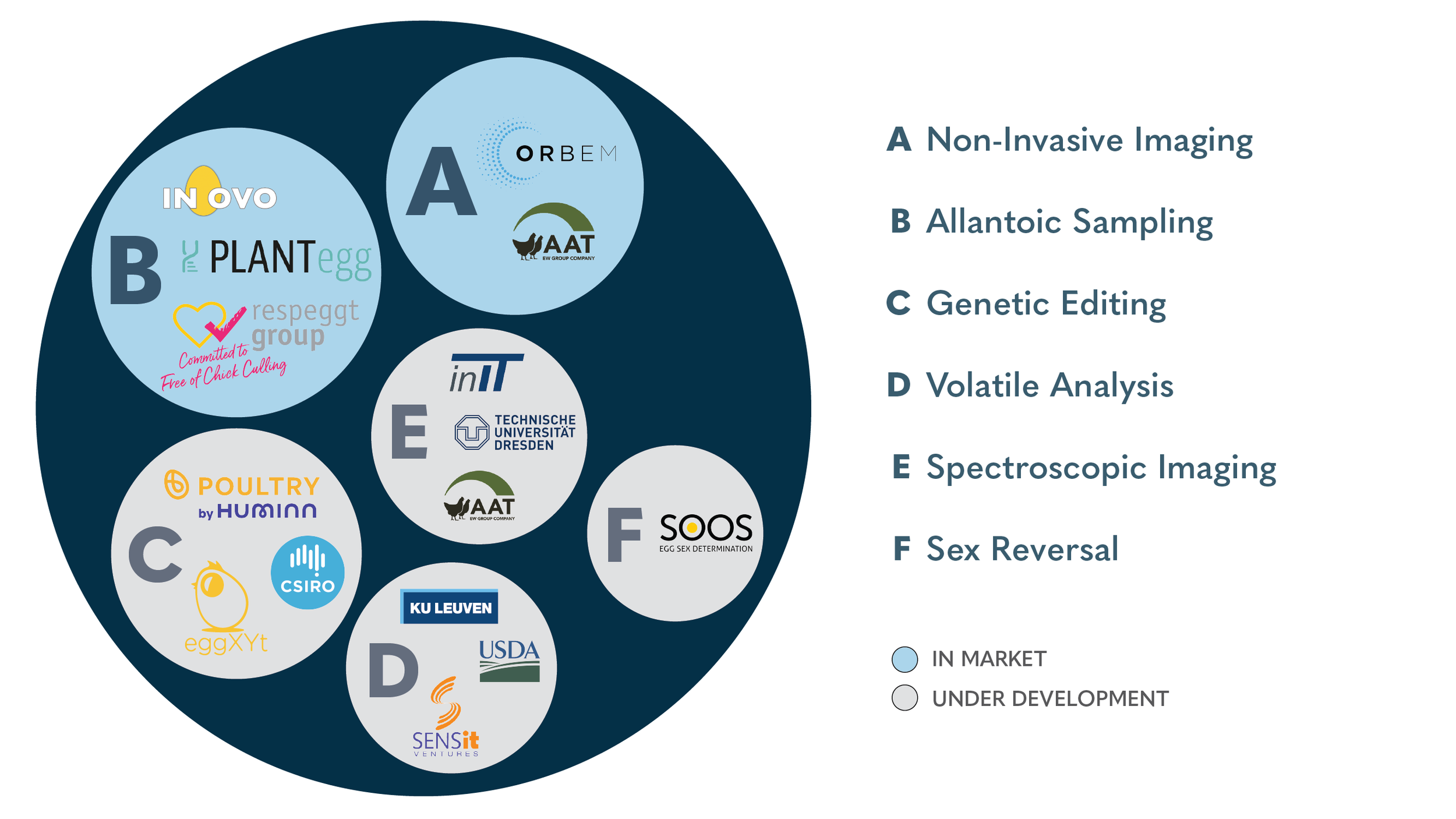Market Snapshot: In-Ovo Egg Sexing
For a full overview of the technology and commercialization status in-ovo sexing technology, see our Overview page.
There are around 300 million egg-laying hens in the US. For each of these female hens, there was male chick that was born then immediately culled. These male chicks cannot be raised for meat, because the breeds of chicken used in the egg and meat industries are different.
Chick culling, in addition to being overwhelmingly unpopular with consumers, is wasteful for the industry. Male eggs take up valuable incubator space, and male chicks must be manually identified and disposed of after birth, in a practice estimated to waste $500 million annually.
A number of innovative companies and labs around the world are developing in-ovo egg sexing techniques to solve this problem. These technologies determine the sex of the embryo early in incubation, so that male eggs can be destroyed before they hatch.
The egg industry has committed to phasing out culling once suitable technology is ready. We believe that time is now. In this post, we’ll give a brief overview of the different technological approaches to solving this important problem.
The Solutions
Industry map of in-ovo egg sexing solutions, as of Q1 2023
Based on publicly available data, we estimate that egg sexing solutions currently have around 10-20% market penetration in Europe, an impressive figure after only a few years. This market share is split across two broad classes of technology, which we call non-invasive imaging solutions, and allantoic sampling solutions.
A) Non-Invasive Imaging
Non-invasive imaging technology finds a way to look “through” the shell of the egg to determine the sex of the embryo inside. Agri-AT, the current market leader with 9 operational machines in 7 hatcheries, uses hyperspectral imaging to determine the color of the embryo’s feathers. This can successfully sex eggs of brown layers, since males and females have different colored feathers. Orbem, a relatively newer player, combines AI with MRI, and can work for both brown and white layers.
The benefits of this class of technologies are that they’re simple and potentially cheaper than other options. However, in order to be accurate, they must wait until a fairly late stage in the embryo’s incubation. Agri-AT has even developed a method to stun the embryos before they are destroyed, to make sure that their death is humane.
B) Allantoic Sampling
Allantoic sampling technologies involve making a tiny hole in the egg shell, taking a fluid sample from inside the egg, and then running a chemical or biological analysis to determine the sex. There are three companies with commercialized solutions in Europe whose technologies vary along a number of important metrics, such as the type of analysis used.
The sampling can be done in an efficient high-throughput manner, but could be more expensive than non-invasive imaging depending on the particular technology. However, the approach can generally work earlier on in the incubation period, around day 9.
Further than these two solutions, a number of other technologies are in early trials, aiming to be able to provide accurate, affordable, and safe sexing solutions to hatcheries at the earliest possible day of incubation:
C) Genetic Editing
Gene editing can be used to assist the sexing process by giving male embryos a genetic marker that allows them to be easily identified, or to stop growing entirely. Importantly, clever breeding strategies allow only the males to carry the genetic trait, so that the females and the eggs we eat are not themselves genetically modified.
Genetic Editing based solutions will require substantial up-front work to integrate the genetic changes into commercial layer breeds, which are highly optimized and tightly controlled. However, once implemented, they could potentially be extremely cheap and accurate, and work as soon as the egg is fertilized. It remains to be seen whether consumers would have concerns about using gene editing in this way, even though the eggs they eat would carry no genetic changes.
D) Volatile Analysis
Eggs naturally give off some odor via molecules that are able to escape through the egg shell, called volatiles. Innovative labs around the world are pursuing technology that can sex eggs by “smelling” these odors. Egg production lines generally already use vacuum suction cups to move eggs around, allowing this technology to potentially integrate easily into existing infrastructure.
E) Spectroscopic Imaging
In this class of technology, a small hole is made in the egg shell to allow for an optical image to be taken of the embryo inside. These imaging technologies will be more complex and expensive than their non-invasive counterparts, but they will be able to work at an extremely early stage of incubation.
F) Sex reversal
In poultry, sex can be controlled by factors outside of genetics. Israeli startup SOOS has an AI-driven incubation protocol which controls humidity, temperature, and sound vibrations to cause embryos that are genetically male to develop as phenotypically females. They’ve demonstrated the ability to hatch females at a rate of 65%, with 11% being sexually reversed males.
These six classes of technologies have different pros and cons, and particular technologies in each class have further strengths and weaknesses relative to one another. It is yet to be determined which solution American producers and consumers will prefer. Innovate Animal Ag can work with American hatcheries to understand which solutions might work best for their particular operation, and for their unique customers.

